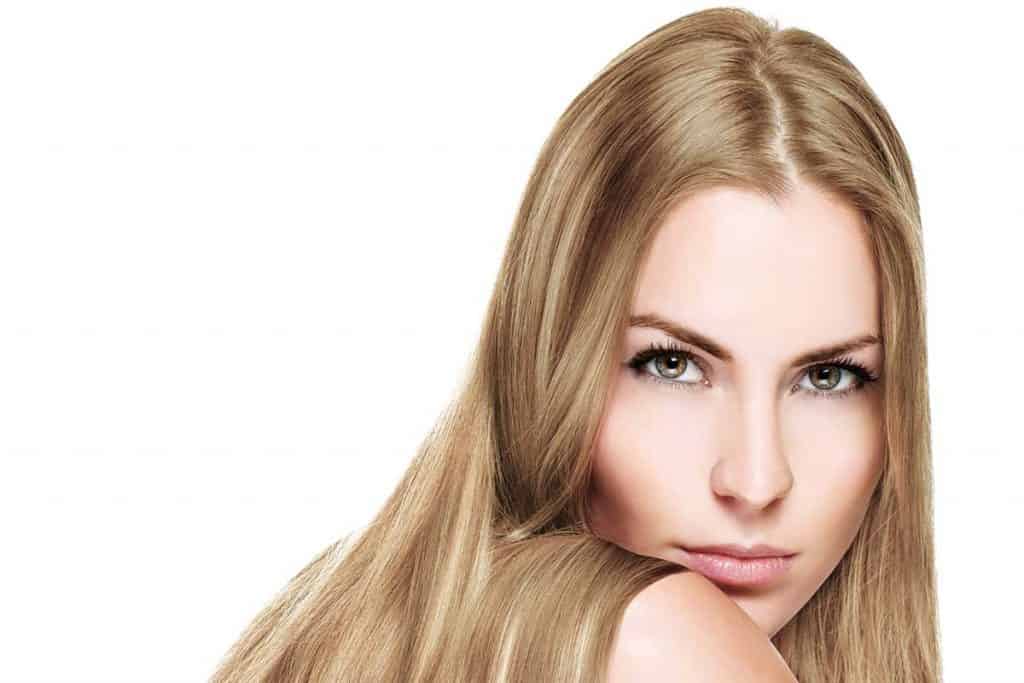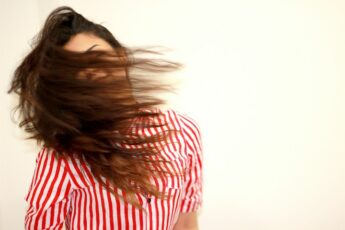Okay, confession time: I used to be a big-time at-home hair bleacher. I have always loved unusual hair colors like pink, purple, and yellow, and all of them require pre-bleaching to even show up on hair. This has definitely taken its toll on my hair, so I had to learn how to keep my hair hydrated to mitigate the consequences.
Nowadays, I leave bleaching to the professionals and advise you to do the same. But hey, things happen, and sometimes we get a little wild with our hair. If you’ve done some bleaching on your tresses and you’re wondering how to rehydrate hair after bleaching, I shall share my wisdom with you. Reclaim your lovely strands from the damage of bleaching agents, and learn some tips for preventing future hair damage!
Before we learn about how to hydrate hair after bleaching, let’s take a look at the process of bleaching and why hair hydration is so important before and after lightening.
Table of Contents
The Bleaching Process
Bleaching lightens the hair by removing pigment through a process called oxidization. Oxidization occurs when peroxide meets ammonia; this is why you have to mix bleach powder (peroxide) with a developer (ammonia).
You should always use a 20 or 30 vol developer when bleaching hair. However, if you’re like a younger version of me and always reach for 40 vol because it’s the most powerful, keep reading because your hair probably needs a lot of help! In the process of bleaching, the cuticle gets raised so that peroxide can remove the pigment, and without adequate hydration, this can damage the hair.
All hair can be bleached. Whether you should bleach it or if you can reach your desired level of blonde in one session of bleaching is a better question to ask yourself.
If you’re trying to go from black to platinum, that will definitely take more than one bleaching session. This should definitely not be attempted by an amateur! If you use too strong of a developer, leave the bleach in for too long, or don’t leave enough time in between lightening sessions, you’re going to have a bad time!
Take it from a person who’s had to have an unfortunate pixie cut more than once: Bleaching can wreak havoc on your hair! You should not be bleaching at home, but if you’re like me and have to learn things the hard way, I am here to help.

The Importance of Hydration for Bleached Hair
Your hair is just like you; it needs hydration to look and feel great. As stated before, the bleaching process raises the cuticle’s outer layer to be penetrated, and hair hydration is key to getting the cuticle to reform to its pre-bleached state. Healthy hair can easily return to its regular state after the product is used.
Damaged hair does not do so well. If your hair gets over-damaged from being bleached too many times or exposed to other damaging things, the hair cuticle can become permanently raised. When this happens, hair cannot hold onto moisture, and it becomes the brittle straw that we all dread. That’s why it’s super important to rehydrate your bleached hair between sessions.
Ways on How to Hydrate Hair after Bleaching
Keeping hair hydrated after bleaching is a multi-step process. You want to think about both what you can do to repair the hair and what you can do to prevent future damage to the hair. For best results, try as many things as you can, and see what works best for your hair.
Use a Keratin Treatment
The first thing most stylists would recommend when trying to rehydrate hair after bleaching is a keratin treatment. Keratin is one of the main proteins that hair loses during the bleaching process, so putting some back in will help to repair the damage and hydrate the hair after it has been bleached.
There are many at-home keratin treatments. Personally, I would recommend L’ANZA Keratin Hair Treatment Healing Oil because it contains a blend of nourishing oils that will repair the hair. The formula is extremely nourishing and contains UV protection to prevent further damage to the hair. L’ANZA Keratin Treatment Healing Oil is especially effective if you like to spend a lot of time outside in the sun.
Create Homemade Coconut Oil Mask
I cannot sing the praises of coconut oil enough. Your skin loves it, your hair loves it, and you can even cook with it. How’s that for an all-in-one product? Use it like any other hair mask: Work the oil onto every strand of the hair, allow the oil to sit for 10-15 minutes, then rinse the oil out. Your bleached hair will thank you for the extra love!
My personal fav when it comes to coconut oil is Sky Organics Extra Virgin Coconut Oil. It is 100% pure, cold-pressed, organic coconut oil. Nothing more, nothing less. I love that it has no additives, so it can be used to hydrate my hair, moisturize my skin, or make a mean stir-fry. It’s also vegan and cruelty-free! If you are wondering how to rehydrate your hair after bleaching naturally, reach for Sky Organics Extra Virgin Coconut Oil.
Use Argan Hair Oil
Not all hair loves coconut oil, and if you’re one of those people, I highly recommend using argan hair oil instead. Argan oil contains a lot of vitamin E, which is super nourishing to hair, skin, and nails. Unlike coconut oil, argan can be left in the hair after application. Argan oil is also great for dry scalps and can be used to help stimulate hair growth. Also, if you’re looking to treat acne and dark circles, you’re in luck — argan oil helps with that too (just like vitamin E)!
If you’re looking for an all-organic, no-frills argan oil treatment, try Organic Argan Oil for Hair and Skin from Kate Blanc. It is 100% USDA-certified organic Moroccan argan oil. I personally am a huge fan of single-ingredient products, especially if you’re using them in addition to more complex keratin hair masks. To use, apply two to three drops to the most damaged areas of the hair, work it in with the fingers, and just leave it. It’s that simple!
Avoid Other Hair Damage
Do Not Wash Your Hair Every Day
This one’s pretty easy. Just don’t wash your hair every day. This is especially useful if you’re bleaching your hair to color it something wild like pink, purple, or rose gold since those colors are all made of semi-permanent dye that will fade with every wash. Learn to love dry shampoo and drop down your number of washes to two to three a week instead of once every day.
Limit the Use of Heat Styling Tools
We all know that heat styling is bad for the hair, so if you really want to bleach your hair, consider going for a no-heat styling method. If you can, allow your hair to air dry. If blow-drying is necessary for your style, make sure that you use a heat protector before exposing your hair to heat.
This is another great reason to wait a few days in between washes; if you use hair products that maintain a style for multiple days, you won’t have to use heating elements as frequently, and your hair will thank you.
Avoid Chemical Treatments That Can Cause Further Damage
Don’t stack a bunch of chemical treatments on your hair at once! You can have it bleached, or you can have it permed; it is ill-advised to try both. I know how tempting it can be to throw everything but the bathroom sink at your hair, saying, “Oh, it’ll grow back!” But it takes a lot of time to grow back, and that unfortunate pixie cut lasts longer than you think! A little patience goes a long way when it comes to your hair.
Only Brush Hair When It’s Dry
When hair is wet, it is more vulnerable to damage. The most likely time your hair is to get damaged is when you are brushing it. Therefore, brushing wet hair is more likely to cause hair to snap and lead to breakage and split ends — unless you use a brush designed for wet hair.
Be extra gentle when brushing hair. Start at the ends, and ideally only brush it when it’s dry.
Sleep with a Silk Nightcap or on a Silk Pillowcase
To avoid tangles that need to be brushed, which can lead to breakage, sleep with your hair in a silk nightcap or on a silk pillowcase. The nightcap may feel a little old-school at first, but I have grown to love mine. I no longer need to brush my hair in the morning. I woke up like this!
Avoid Hair Ties That Use Metal
If you own any hair ties that use a small piece of metal to hold the hair tie together, throw it away! Those are the worst things you can use to tie your hair back. They will absolutely snag your hair and cause split ends. Scrunchies are deliciously 90s and 100% hair-safe. If those aren’t your style, there are also soft cotton hair ties. Also, be aware of metal hair clips that can catch and snag the hair.
Opt for Loose Braids Over Ponytails

Your hairstyle can absolutely cause damage to your hair! Tight buns and ponytails can pull on the scalp and cause damage to the hair. Loose braids are a great way to keep your hair back without damaging it. If you have shorter hair, a pair of French braids can effectively keep hair out of your face while still looking super cute. If you are absolutely in love with your perky ponytail, you don’t have to give it up, just give your scalp a chance to rest every other day. It might even reduce your headaches if you’re prone to them.
FAQs
Can you repair dry bleached hair?
Yes, you can repair dry hair. The most commonly used product to rehydrate your hair after bleaching is a keratin treatment. This will help to put the keratin back into your hair. Salons will often use a flat iron to seal in the serum, making it last for up to two weeks, but there are plenty of great at-home keratin treatments available.
Should I put coconut oil on my bleached hair?
Yes! Coconut oil is great for restoring hydration to bleached hair. It can be used plain or mixed with avocado, honey, and olive oil for an at-home hair mask. Coconut oil can also be used on skin and nails, and it is often safe to be eaten. If you don’t already have coconut oil in your home, go get some!
How do you rehydrate over-processed hair?
There are several options when it comes to hydrating hair after bleaching. Some of the best things you can do for hair that has lost moisture due to bleaching are using a keratin treatment, making an at-home coconut oil hair mask, and using argan hair oil. It is also important to take steps to limit other sources of damage to the hair, which can cause it to lose moisture.
Dry No Longer!
Okay, so even if you haven’t decided to leave bleaching to the professionals, we’ve still learned a lot about how to hydrate hair after bleaching. By using keratin treatments, coconut oil masks, and argan hair oil, hair can be rehydrated after bleaching. You will also want to take steps to reduce other potential sources of damage to your hair. And with that, I shall leave you. Go forth and be dry no longer!
0


